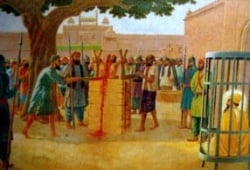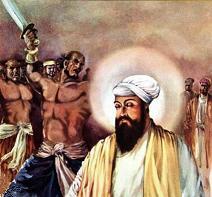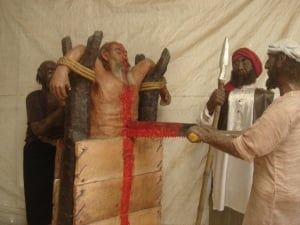Bhai Mati Das

Bhai Mati Das (d. 24 November 1675) (Punjabi: ਭਾਈ ਮਤੀ ਦਾਸ) is one of the great martyrs in Sikh history. He along with his younger brother Bhai Sati Das and Bhai Dyal Das, all disciples of the ninth Sikh Guru, Guru Teg Bahadur, were executed along with Guruji at the Kotwali (police-station) near the Sunehri Masjid in the Chandni Chowk area of Old Delhi, under the express orders of emperor Aurangzeb.
Early life
Born to a Brahmin[1][2] family of the Chhibber clan, Bhai Mati Das belonged to the village of Karyala, a stronghold of the Chhibbers, in the Jhelum District in Punjab (Pakistan), about ten kilometres from Chakwal on the road to the Katas Raj Temple Complex. The village stands on the top of the Surla hills. This part of the country is known as Dhani meaning rich. A few kilometres away are the Salt Mines and coal mines of Dandot. The Katas lake is beautiful.
His grandfather, Bhai Praga, had embraced the Sikh faith in the time of Guru Hargobind and had taken part in battles with the Mughal forces. His uncle Dargah Mall served Guru Har Rai and Guru Har Krishan as Diwan or manager of the household. Bhai Mati Das and his brother, Bhai Sati Das, assisted Dargah Mall in his work during Guru Tegh Bahadur's time. The former was himself appointed Diwan along with Dargah Mall who was by then considerably advanced in years.
Diwan Mati Das accompanied Guru Tegh Bahadur during his travels in the eastern parts in 1665-70. He was one of the companions of the Guru who were detained at Dhamtan in 1665 and then released from Delhi at the intervention of Kanvar Ram Singh, of Amber. In 1675, when the Guru set out from Anandpur for Delhi, Bhai Mati Das bravely faced certain death as he volunteered to accompany Guru Tegh Bahadur to Aurangzeb's Court to confront the Emperor over his threat of forcing the Pandits of Kashmir to convert to Islam or be killed. The Guru and his steadfast companions were arrested under imperial orders, and taken in chains to Delhi. Upon his refusal to forswear his faith, he was tortured to death. He was, on 24 November 1675, sawn in half, from his head - downwards.
Devotion to the Gurus
Mati Das was the son of Hira Nand, a disciple of Guru Har Gobind, under whom he had fought in many battles. He survived the Guru, and a little before his death he had entrusted his two sons, Mati Das and Sati Das to the care of Guru Har Rai, who had assured the dying man of his full attention and help. Both the lads remained attached to the Guru's family at Kiratpur. When Guru Har Krishan was summoned to Delhi by Aurangzeb, both the brothers, Mati Das and Sati Das, were present in his entourage along with Dyal Das and Gurditta, a descendant of Bhai Budha (different from Baba Gurditta, the son of Guru Hargobind, brother of Guru Teg Bahadur and father of Guru Har Rai).
Guru Tegh Bahadur
After Guru Har Krishan's death at Delhi, when Guru Tegh Bahadur was 'found' among the many pretenders to the Sikh Guruship who had set up camp in the city where Guru Har Krishan had said the next Guru was to be found, these two brothers were included in the deputation of five men containing Dyal Das and Gurditta to sent to Bakala to confirm the nomination of Teg Bahadur as the ninth Guru at the village of Bakala where the new Guru had been residing. The Guru was pleased to offer the two important portfolios of finance and home departments to Mati Das and Sati Das respectively. Both knew the Persian language well, and were quite familiar with the working of the Guru's durbar. The departmnent of household affairs was entrusted to Dyal Das.
After Guru Tegh Bahadur was refused entry to the Harmandar Sahib at Amritsar and had founded a new city in at the base of the Sivalik Hills that later grew into Anandpur Sahib, the two brothers accompanied Guru Teg Bahadur during his journey to Assam. Guru Tegh Bahadur bought a hillock near the village of Makhowal five miles north of Kiratpur and established a new town. Mati Das and Sati Das were present at the foundation of the new city. (Which was later expanded and renamed Anandpur (the abode of bliss) by his son Guru Gobind Rai). The Guru's council of administration then consisted of Mati Das, Sati Das, Dyal Das and Gurditta. When the Guru was arrested and taken to Delhi, these four persons were with the Guru.
Martyrdom

Guru Gobind Singh
- Main article: Martyrdom of Guru Tegh Bahadar
At Delhi, the Guru and his four companions were summoned into the council chamber of the Lal Kila (the Red Fort}. The Guru was asked numerous questions on religion, Hinduism, Sikhism and Islam. It was suggested to the Guru that he should embrace Islam. On the Guru's emphatic refusal to abjure his faith, he was asked why he was called Teg Bahadur (Brave Swordsman). Bhai Mati Das immediately replied that the Guru, then named Tyag Mal, had won the title by inflicting a heavy blow on the imperial forces at the young age of fourteen. He was reprimanded for his breach of etiquette and outspokenness. As Mati Das was a Brahmin, the Guru was asked why he had courted the company of such men when he did not believe in caste, and why he was defending the Brahmins of Kashmir. The Guru replied that when a person became a Sikh, he lost his caste. As for the Kashmiri Pandits, it was his duty to raise his voice against cruelty and injustice. The Guru and his companions were ordered to be imprisoned and tortured until they agreed to embrace Islam.
After a few days, Guru Teg Bahadur and three of his companions were produced before the Qazi of the city. Gurditta had managed to escape. He remained in hiding in the city, and in spite of all the efforts of the Government, he could not be traced. The Qazi turned to Mati Das first and asked him to embrace Islam. He refused to do so. He was condemned to an instantaneous death.
The executioners were called and the Guru and all the three of his companions were made to sit at the place of the execution. Bhai Mati Das approached the Guru with his palms pressed together , as he asked for his blessings, saying that he was happy to be the first to achieve martyrdom.
The Guru blessed him telling that they must resign themselves cheerfully to the will of the Lord. He praised him for his lifelong single-minded devotion to him and his cause. With tears in his eyes, he bade him farewell saying his sacrifice would occupy an abiding place in history. Mati Das touched the Guru's feet, embraced his friend and brother, and came to his place.
Mati Das while standing erect was tied between two posts. He was asked if he had any parting words, to which Mati Das answered, "I request only that my head be turned toward my Guru as I am executed." Two executioners placed a double-handed saw on his head. Mati Das serenely uttered "Ek Onkar" and started reciting the Japji Sahib, the great morning prayer of the Sikhs. He was sawn in half from head to loins. It is said that even as the body was being sawn into two, the Japji continued to reverberate from each part until it was all over.
Sati Das and Dyal Das
Sati Das condemned these brutalities and spoke harshly to the people in-charge. His protests were ignored and he too was tortured. He was eventually wrapped in cotton and burnt alive. The Guru witnessed all this savagery with divine calm.
Dyal Das also spoke tersely to the Emperor and his courtiers for this infernal and barbaric acts. The government leaders refused to listen to him too. They tortured him and eventually, he was tied up like a bundle and thrown into a huge cauldron and boiled alive. He was roasted alive into a block of charcoal. The Guru was deliberately forced to witness these barbaric acts to torture on the 3 Sikhs.
Guru Teg Bahadur's Martyrdom
Mati Das, Dyal Das and Sati Das were tortured and executed on three consecutive days.
Guru Teg Bahadur was beheaded by an executioner called Jalal-ud-din Jallad, who belonged to the town of Samana in present-day Haryana. The spot of the execution was under a banyan tree (the trunk of the tree and the nearby well, where he bathed are still preserved), now opposite the Sunheri Masjid near the Kotwali in Chandni Chowk where he was lodged as a prisoner, on November 11, 1675.
His head was carried away by Bhai Jaita, a disciple of the Guru, to Chak Nanaki (later renamed Anandpur Sahib) where the nine-year old Guru Gobind Rai cremated it. The gurdwara now at this spot is called Gurdwara Sis Ganj Sahib as is anotherGurdwara in Delhi. His body, which was to be quartered, was stolen under the cover of darkness of a sudden sand storm. The bold daring of Lakhi Shah Vanjara, another disciple, abled him to carry it away hidden in his cart under a load of hay. He then sacrificed his meager home to cremate his Guru's remains, by setting it afire. At this spot, the Gurdwara Rakab Ganj Sahib stands today. Later on, the Gurdwara Sis Ganj Sahib, was built at Chandni Chowk at the site of the Guru’s martyrdom.
Bhai Mati Das' legacy
In recognition of the devotion and supreme sacrifice made by Mati Das, Guru Teg Bahadur bestowed the title of Bhai on him. In course of time, all Chhibbers belonging to the village of Karyala adopted this title.
Bhai Mati Das occupies a premier position in the pantheon of Sikh martyrs.
Dialogue
One of these great men was called Bhai Mati Daas Ji. The Qazi, the Muslim priest, asked Bhai Mati Daas: “Accept Islam and you will receive all the happiness’ and comforts of the world. We will give riches, as many wives as you wish and make you a courtier of the Mughal royal court.”
Bhai Mati Daas replied: “And if I don’t accept Islam then what will I face?”
“Then you will be faced with death! You will be sawn alive”, said the Qazi.
Bhai Mati Daas said to the Qazi: “O Qazi I have tasted all of the world’s happiness’ and comforts. My family are well off, I have a wife, children and parents. I am healthy and experienced all the world has to offer me…” “…However I have not tasted the teeth of your beloved saw! I would rather taste the teeth of the executioner’s saw than have all the comforts of the world.”
The Mughal Emperor Aurangzeb ordered the executioners to give a taste of the saw’s teeth. The executioners placed the saw on top of Bhai Mati Daas’ head and sawed downwards up to the length of four fingers.
Blood was pouring from the head. The hair was shining with bright red. The face was smothered with the colour of blood.
“You have tasted the teeth of the saw. Now tell me if you wish to accept Islam and have all the comforts and riches of the world or face death”, asks the Qazi.
Bhai Mati Das replies, “I would rather face death and take on the teeth of the saw than be engulfed in the pain and misery which the comforts of the world bring.” ‘Sir jaave ta jaave, par meri Sikhi sidq na jaave… if I have to die, so be it, but may my Sikh faith never go.” [Sikh proverb]
The Qazi, executioners and the rest of the crowds were shocked at Bhai Mati Daas’ decision.
The executioners ask, “What is your last request?”
Bhai Sahib says, “I don’t have one but two requests! Firstly may my body be facing Guru Tegh Bahadar Ji, I never wish to turn my back to me Beloved Guru. Secondly I request you to execute me slowly. I wish to recite ‘Jap Ji Sahib’. So do not saw my tongue off until I utter: ‘jinni naam dhiaayiaa, gaye masakhat ghaal; naanak te mukh ujley kehtee chhutee naal.’’ ‘Where the Holy people constantly vibrate on the Kirtan of the Praises of the Lord of the Universe, O Nanak - the Righteous Judge (Recorder of Karma) says, ""Do not approach that place, O Messenger of Death, or else neither you nor I shall escape [from God]!""’ [Ang. 256]
The executioners were moved by this. “People usually ask us to hurry up the execution, so that they feel as little pain possible. We have never been requested to kill somebody slowly.”
The saw was put on Bhai Mati Daas’ head. “Ek Oangkaar, Sat-naam, Karta Purkh, Nir-bhau, Nir-vair, Akaal Moorat, Ajooni, Sai-bhan, Gur-prasaad…” Bhai Mati Daas shows no sign of distress and continues to recite Jap Ji Sahib. Eventually the body split into two pieces.
Bhai Mati Daas never gave up Sikhi or the support of Gurbani when challenged with death. Bhai Mati Daas didn’t merely utter Gurbani but, he lived Gurbani and put Guru Ji’s Divine words into action.
Now we are not shadowed with the choice choosing between torturous deaths, conversion or keeping our Sikh faith.
See also
External Links
Video
- Bhai mati das shaheedi Comment by Kabir700: Watching this, makes my heart crumble- I am simply awestruck..These men were not human beings as we define humans today- they were elevated, pure, highly righteous souls called upon this Earth to set an example with practical actions, not words.
References
- 1. Bhalla, Samp Das, Mahima Prakash. Patiala, 1971
- 2. Gian Singh, Giani, Sri Gur Panth Prakash. Patiala, 1970
- 3. Santokh Singh, Bhai, Sri Gur Pratap Suraj Granth. Amritsar, 1927-35
- 4. Macauliffe, Max Arthur, The Sikh Religion. Oxford, 1909
- 5. Trilochan Singh, Guru. Tegh Bahadur. : Prophet and Martyr. Delhi, 1967
- 6. Harbans Singh, Guru Tegh Bahadur. Delhi, 1989
- ^ {{ #if: O. P. Ralhan | {{ #if: | [[{{{authorlink}}}|{{ #if: | {{{last}}}{{ #if: | , {{{first}}} }} | O. P. Ralhan }}]] | {{ #if: | {{{last}}}{{ #if: | , {{{first}}} }} | O. P. Ralhan }} }} }}{{ #if: O. P. Ralhan | {{ #if: | ; {{{coauthors}}} }} }}{{ #if: | [{{{origdate}}}] | {{ #if: | {{ #if: | [{{{origmonth}}} {{{origyear}}}] | [{{{origyear}}}] }} }} }}{{ #if: | ({{{date}}}) | {{ #if: 1997 | {{ #if: | ({{{month}}} 1997) | (1997) }} }} }}{{ #if: O. P. Ralhan | . }}{{ #if: | "{{ #if: | [{{{chapterurl}}} {{{chapter}}}] | {{{chapter}}} }}",}}{{ #if: | in {{{editor}}}: }} {{ #if: | [{{{url}}} The Great Gurus of the Sikhs] | The Great Gurus of the Sikhs }}{{ #if: | ({{{format}}}) }}{{ #if: | , {{{others}}} }}{{ #if: | , {{{edition}}} }}{{ #if: | , {{{series}}} }}{{ #if: | (in {{{language}}}) }}{{ #if: Anmol Publications | {{#if: | , | . }}{{ #if: | {{{location}}}: }}Anmol Publications }}{{ #if: 16 | , 16 }}{{ #if: | . DOI:{{{doi}}} }}{{ #if: | . {{{id}}} }}{{ #if: 9788174884794 | . ISBN 9788174884794 }}{{ #if: | . OCLC {{{oclc}}} }}{{ #if: | {{ #if: | . Retrieved on [[{{{accessdate}}}]] | {{ #if: | . Retrieved {{ #if: | on [[{{{accessmonth}}} {{{accessyear}}}]] | during [[{{{accessyear}}}]] }}}} }} }}.{{ #if: His life-long companion Bhai Mati Das, a Mohyal Brahmin of Kariala in Jehlam district... | “His life-long companion Bhai Mati Das, a Mohyal Brahmin of Kariala in Jehlam district...” }} </in
- ^ {{ #if: Hari Ram Gupta - Sikhs | {{ #if: | [[{{{authorlink}}}|{{ #if: | {{{last}}}{{ #if: | , {{{first}}} }} | Hari Ram Gupta - Sikhs }}]] | {{ #if: | {{{last}}}{{ #if: | , {{{first}}} }} | Hari Ram Gupta - Sikhs }} }} }}{{ #if: Hari Ram Gupta - Sikhs | {{ #if: | ; {{{coauthors}}} }} }}{{ #if: | [{{{origdate}}}] | {{ #if: | {{ #if: | [{{{origmonth}}} {{{origyear}}}] | [{{{origyear}}}] }} }} }}{{ #if: | ({{{date}}}) | {{ #if: 1978 | {{ #if: | ({{{month}}} 1978) | (1978) }} }} }}{{ #if: Hari Ram Gupta - Sikhs | . }}{{ #if: | "{{ #if: | [{{{chapterurl}}} {{{chapter}}}] | {{{chapter}}} }}",}}{{ #if: | in {{{editor}}}: }} {{ #if: | [{{{url}}} History of the Sikhs] | History of the Sikhs }}{{ #if: | ({{{format}}}) }}{{ #if: | , {{{others}}} }}{{ #if: | , {{{edition}}} }}{{ #if: | , {{{series}}} }}{{ #if: | (in {{{language}}}) }}{{ #if: Munshiram Manoharlal | {{#if: | , | . }}{{ #if: | {{{location}}}: }}Munshiram Manoharlal }}{{ #if: 211 | , 211 }}{{ #if: | . DOI:{{{doi}}} }}{{ #if: | . {{{id}}} }}{{ #if: | . ISBN {{{isbn}}} }}{{ #if: | . OCLC {{{oclc}}} }}{{ #if: | {{ #if: | . Retrieved on [[{{{accessdate}}}]] | {{ #if: | . Retrieved {{ #if: | on [[{{{accessmonth}}} {{{accessyear}}}]] | during [[{{{accessyear}}}]] }}}} }} }}.{{ #if: The Guru's companions included Mati Das, a Mohyal Brahman... | “The Guru's companions included Mati Das, a Mohyal Brahman...” }} </in

